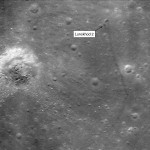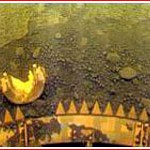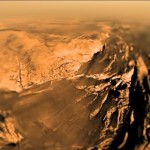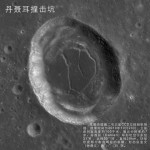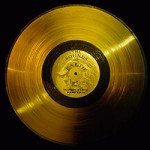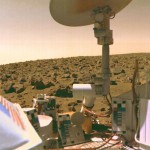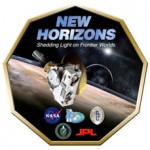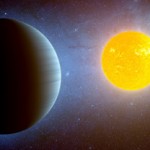The Art Life’s editor and space buff Andrew Frost celebrates the end of NASA’s manned mission program with a pick of ten essential unmanned space missions, from Russian failures and triumphs, to NASA limited edition classics to an open invitation to aliens to come and join our fondue party…
1. Lunokhod.
While NASA grabbed all the headlines in the late 1960s and early ‘70s with their successful Apollo missions the Soviets had spectacular success with their ambitious Lunokhod program putting two remote controlled lunar rovers on the Moon in 1970 and 1973. Initially designed as advance missions for the Soviet’s own [eventually abandoned] plans for crewed missions and schemes to establish permanent bases, Lunokhod’s 1 and 2 gathered thousands of images and hundreds of hours of video footage of the lunar surface. The rovers, each about the size of a small car and powered by solar panels and an onboard polonium-210 heat source, were the first remote controlled roving devices to be landed on another moon or planet, a record unbroken until NASA successfully put Pathfinder on Mars in 1997. The secrecy surrounding Lunokhod and other Russian missions often meant that successes were often ignored in the West and, bizarrely, after the fall of the Soviet Union information on the exact location of the two lunar rovers was lost. Last year, when images from NASA’s Lunar Reconnaissance Orbiter [a mission to map the moon’s surface in hi res detail] were released online, a researcher from Western Ontario University was able to positively indentify Lunokhod 2’s final position – right at the end of a 35 kilometre long set of tire tracks that have laid undisturbed in the Moon’s surface for nearly four decades.
2. Beagle 2
The Beagle 2 Mars lander is the only space mission to have had an official art world connection. Launched in 1999 by the European Space Agency, Beagle 2 was the second part of a two part mission that involved the B2 lander and an orbiting camera known as Mars Express. Blur’s bass player Alex James, a long time space mission buff, successfully lobbied the ESA to include a track by his band to be used as the signal that would be broadcast to Earth upon the Beagle’s successful landing. It was also through James that the other art component of the mission was included – a Damien Hirst spot painting that would be used to calibrate the lander’s cameras once on Mars. While the orbiting camera part of the mission deployed perfectly the Beagle 2 – which was to look for signs of Martian life with the most sophisticated tests yet devised – suffered what is euphemistically termed a “hard landing”. The majority of deep space missions, especially those requiring a landing or other tricky technical manoeuvres after years or decades in space, end in failure. So a fifty percent success rate isn’t all that bad – and Hirst has the honour of putting the first art work on another planet.
3. Venera 1 – 16
Speaking of failures, the Russian space program experienced many space mission disasters but, since the official line was to deny that any such failures existed, the Soviet space program was nothing but a series of awe-inspiring and glorious successes! No fewer than 16 official attempts [and perhaps a dozen more unofficial attempts] were made to launch probes to Venus and, although many early missions ended in premature failure, the Russians eventually managed to put probes into the planet’s extremely hostile upper atmosphere. Venera 3 has the dubious honour of being the first manmade object to land on another planet on March 1st 1966 but was more of an “uncontrolled” impact. In 1970 Venera 7 made a soft landing on Venus where it survived for a little over 23 minutes in balmy temperatures of 465C and in winds in excess of 100 metres per second. Later missions equipped with cameras had “lens cap failures” where the camera lens caps refused to pop off but with typical Russian stoicism Soviet scientists eventually managed with Veneras 13 and 14 to capture the first images of the surface of Venus before the 1 ton vehicles promptly melted. And it’s not over. In 2016 the Russian Space Agency will launch Venera-D [D for “Dolgozhivushaya” or long-lasting] to orbit the planet and map its surface with cloud penetrating radar.
4. Cassini-Huygens
There are plenty of failures in space missions but sometimes they come off and in spectacular fashion. The Cassini-Huygens probe, from launch, journey and separation to landing, has produced incredible results. A joint mission by NASA, the ESA and the Italian Space Agency, Cassini-Huygens was launched in late 1997 to study Saturn, its moons and land a probe on the surface of Titan. Absurdly ambitious, the mission reached Saturn space in mid-2004 and began making a series of stunning discoveries, not least of which was finding new moons inside Saturn’s rings. But for planet freaks, the best was yet to come. On Christmas Day 2005 the Huygens probe separated from Cassini and descended into the rich atmosphere of Titan, cameras recording its four hour long balloon-assisted decent. Titan is the only satellite in the Solar System with a dense atmosphere, cloud cover and what appeared to be seasonal variations in brightness – what might lie below? Oceans? Some kind of primitive life? Scientists are still puzzling over the images sent back to Earth finding evidence of river systems and what appeared to be a shoreline. As the Jet Propulsion Lab website notes: “The pictures of drainage channels and pebble-sized ice blocks surprised scientists with the extent of the moon’s similarity to Earth. They showed evidence of erosion from methane and ethane rain. “It was eerie,” said Jonathan Lunine, an interdisciplinary Cassini scientist at the University of Rome, Tor Vergata, and University of Arizona, Tucson. “We saw bright hills above a dark plain, a weird combination of light and dark. It was like seeing a landscape out of Dante.’” While there’s no official art world involvement in the mission such as with the Beagle 2 lander, filmmaker Chris Abbas has made a pretty fabulous short film using NASA footage and some appropriately moody music.
5. Hayabusa
So how hard would this be – launch a spacecraft from Earth, fly it a billion miles out to an asteroid called Itokawa, land a probe on its surface, collect samples, take off and fly back to Earth where it is successfully recovered and the asteroid dust samples taken to the lab? Incredibly this mission was undertaken by the Japan Aerospace Exploration Agency in 2003 and was an almost total success, [although the mini-lander Minerva that was supposed to separate from Hayabusa and land on the asteroid and then “hop” across its surface like an adorable anime character was lost in space…] The mission was designed for two purposes – one, to demonstrate to the world that the Japanese space agency could do some pretty amazing things, and two, match up samples of meteorites found on Earth with pristine samples of asteroids found in space. Mission accomplished.
6. Chang’e-2
So what’s a superpower to do with its space program? Chinese aspirations for space exploration are ambitious with plans for an orbiting space station, an eventual manned mission to the Moon and steps beyond to Mars. In 2002 China became only the third country to put a man in space and in 2008 three men went into space aboard a Shenzhou [Divine Vessel] 7, two of whom went for a space stroll… But aside from their successful return [and launching the word “taikonaut” on the world] many of China’s announced plans have yet to be realised. Meanwhile the Chang’e-2 space probe successfully completed its task to scout landing spots for the Chinese moon rover missions before being blasted off into deep space where it will hang around at roughly 1.5 million miles from Earth being used as a target to perfect Chinese tracking technology. Critics of the Chinese space program point out that all of its successes have already been achieved by the US and Russia – but on the other hand, China has done it much cheaper – the price tag for Chang’e-2 was just $134 million USD. Or to put that in art world terms – it was cheaper than the Museum of Old and New Art.
7. Voyager I & II
You can follow Voyager 2 on Twitter. The probe’s current position is relayed to followers every week or so. The most recent tweet read: “I am currently 13 hrs 08 mins 49 secs of light-travel time from Earth (2011:165:2L).” That’s approximately 9 billion miles from Earth where the two spacecraft are passing through what is called “magnetic bubbles” at the very edge of the heliosphere [where the sun’s solar wind is pushed back by the pressure of interstellar gas]. Launched 33 years ago the twin spacecraft have achieved some amazing discoveries – from their initial mission to photograph Jupiter and Saturn to the detection of volcanism on Io and the frozen oceans on Europa, to their flybys of Uranus and Neptune, the Voyagers are now about to leave the Solar System. And for retro media buffs, who can’t love the two limited edition gold albums affixed to the spacecraft, snappily entitled “Sounds of Earth”? Each album has a special gold cover explaining where the spacecraft came from and includes images of a smiling naked man and friendly naked woman. Ok, it was 1977 when the spacecraft were launched and perhaps aliens might be expecting a fondue shindig, but we still like to party, right?
8. Viking’s Red Skies
NASA works on the principal that it’s cheaper to build two of something than just one and so, like the Voyager missions, the Viking program sent two missions to Mars in 1975, each consisting of an orbiting camera and a lander. The two Viking missions were successful returning pictures of the planet from orbit – including the notorious “face on Mars” image – while the landers gave Earthlings their first glimpse of the surface of the planet, albeit the rather boring-looking rocky terrain around Ares Vallis. The Viking lander missions are primarily remembered for two things – the first being the incredibly cool looking red sky of Mars and the failure to detect life. But in retrospect things were not quite as they seemed. The deep red colour was the result of un-calibrated colours with Mars having only a very light pink tint to its sky and sunsets indistinguishable from those on Earth [if slightly dimmer and the sun smaller in the sky]. And those tests for life? One turned up a positive result, two didn’t. Always cautious, scientists concluded that the tests were inconclusive at best but most likely indicating no signs of life. However, in 2008 when the Phoenix Lander mission detected signs of a compound in the soil that only occurs in the presence of microbial life [and throwing doubt on the Viking mission’s original test methodology] well – maybe there’s life in those red rocks after all…
9. New Horizons
Poor Pluto. Despite being demoted from the status of a proper planet to a mere “dwarf planet” on account of its size, weight and bizarre orbit, it still has many attractions. Pluto is covered in nitrogen, methane and carbon monoxide ices and has an atmosphere of gases that rise from the ice in summer but fall back to the surface in winter. Pluto’s orbit brings the planet closer to the sun than Neptune but at its farthest point it’s nearly 50AU [50 times the distance between the Earth and the Sun] away. It has three moons, the largest being Charon [pronounced Sharon] and its year lasts 248 of your Earth years. That’s what’s known. What isn’t known is why it changes colour, what it’s made of and whether it’s a part of the Kuiper Belt proper. The New Horizons mission is already more than half way to Pluto where the plucky spacecraft will meet up with the planet and its moons in July 2015. After that, it’s full steam ahead and out into the mysterious Kuiper Belt.
10. Future Missions
The last NASA space shuttle mission ST 135 is scheduled to launch on July 8, 2011 concluding what has become known as the “space shuttle era” that began in 1981. Manned missions to anywhere but the International Space Station via a Russian rocket may be off the agenda for awhile but there are plenty of unmanned space missions to look forward to… Along with Russia’s planned return to Venus and China’s punt for putting taikonauts on the Moon, NASA and the ESA are discussing a joint mission to Jupiter’s moon Europa. Still in the planning and funding stages, the mission, if launched, could put a lander on to Europa to find out whether there’s liquid water beneath its iceberg covered surface. But the most astounding discoveries may be found a lot closer to home as NASA and other agencies perfect techniques to detect extrasolar planets [planets in other solar systems] from right here on Earth. So far more than 550 extrasolar planets have been found – it’s only a matter of time before an Earth-like planet is found in an orbit conducive to life.
